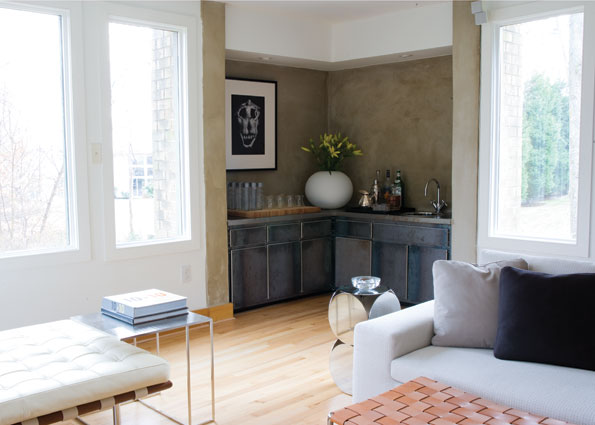Architect Deborah Kalkstein takes us inside her family’s contemporary oasis.
By Ernesto M. Santalla AIA, LEED AP

Architect Deborah Kalkstein with dog Hilton stand at the entryway of her modern Potomac, Md. home. (photo by John Heale)
Deborah Kalkstein, a modernist architect trained in the style of the Bauhaus, has her roots in Lima, Peru where she hails from a creative family of architects. So when she moved to Washington after attending school in Lima and Milan (where she met her husband Carlos Bachrach), she quickly learned that Washington is entrenched in tradition and its residents are most comfortable in conservative living quarters. Convinced her style and aesthetic has a place in the District, she pursued her love for design, found her own projects, and launched her firm Contemporaria. In the process, she met forward-thinking stars of the construction industry and furniture manufacturers.

Husband Carlos Bachrach, Camille Bachrach, Deborah Kalkstein, and Kevin Bachrach outside their family home. (photo by: John Heale)
Her next endeavor: a retail concept for fine European furnishings, lighting and accessories, also called Contemporaria, opened in Bethesda in 1999 and then a second location in Cady’s Alley in Georgetown in 2004. “Washington was so predictable (boring,) when I first came here.
I traveled to New York constantly to shop for furniture and eat at good restaurants.” But no longer. The city has changed and so has the world that Kalkstein lives and works in.
Architecture and interior design blend seamlessly in the Potomac home she shares with Carlos and their two children Camille and Kevin.
As one of the few non-colonials in the neighborhood Kalkstein declared it “a work in progress,” from the moment she spotted it. Her ideas on architecture, interiors, furniture, art, lighting and materials showcase how comfortable, inviting and livable modern can be. Collectibles in the house include iconic furniture by Mies van der Rohe and Marcel Breuer, both masters of modern architecture. The family’s most notable art includes a painting by A.
Vera: a socio-political commentary on Spain under Franco and the monarchy; and a Jordan Doner photograph, a masterpiece of illusion. Furniture from Minotti, Bonacina, Kartell, and Paola Lenti represent the work of generations of furniture makers.
What gives this house a soul, however, is the way it comes together as a livable art form.
Good design is about the occupant, not the designer or architect, even though in this case, Deborah is all three. They all participate in the process, including the kids. They chose the color of their rooms and Mom worked with them to create the environment they want to live in. Guests feel equally at home and welcome. Large, open spaces filled with light flow gracefully with beautiful, comfortable furniture suited for small, intimate gatherings or large parties. Here, beauty is not only to behold, it’s to feel, touch and live it.
Carlos travels to Lima on business every month. Deborah visits several times a year for special occasions or when she feels the longing for the ordered chaos of Lima. “My family and friends are there. I am firmly rooted in my country of origin. Perú owns my heart, but my life is here in Washington.
”

The large glass table in the dining room serves not only as a contemporary statement piece, but also provides ample seating for family and friends. (Photo by John Heale)

Art as a focal point and low-to-the-ground seating renders the Bachrach’s family room both modern and playful. (Photo by John Heale)

Framing their children’s artwork and including a chalkboard height chart adds more than a touch of whimsy to the family’s dining area. (Photo by John Heale)

